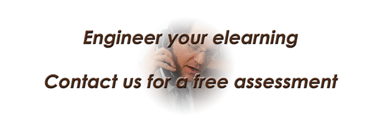I wanted to make this post about sharing my experience with my daughter’s remote education during this 2020 pandemic. I really don’t want to make it a rant of complaints on the shortcomings of the system offered by her school after we went remote because I know her teacher was doing her best under the circumstances, and I don’t think she was ready for this kind of modality in the first place. Most teachers do not receive training on building eLearning solutions for basic education.
I work in the area of adult education so I cannot claim I know much about educating children but I do know how to make eLearning that works and, unfortunately, that is not what I saw during the time my daughter was in remote learning (she still is in this modality).
In fact, that is what they call it: remote learning. The school is not even using the term eLearning. My guess is that they just want to go back to in-person modality once this pandemic is under control, and bury and forget about the remote part of learning. Repeatedly, I get emails from the school principal inviting us to take our daughter back to the classroom but we are not ready to make that commitment, even though the school is reporting almost a zero contagion rate.
And so we helped my daughter end her second grade last July and then start her third grade still in remote learning. Here I need to commend my wife for her help during this time. While I was working remotely, she had to help our third grader because I was unavailable. I like to be involved in her education but there were times when I could just not be there to help, so lots of cheers to my wife for carrying the load for me.
I remember the chaos created by this sudden change when this whole thing started and the school chose Microsoft Teams for remote learning. Neither teachers nor administrators were prepared for this sudden shift, I do not believe there was anything on the books about what to do for such case (I hope they have learned the lesson and added plans like this for any similar situation in the future). Well, now imagine the level of preparation that the parents had at this point. During the first week of classes, I could see the results of unforeseen consequences of this mode of learning. I could see parents on the screen struggling to make this work for their kids. I saw kids sitting in high traffic places at home so people were walking in and out of the camera view, this of course created a series of problems for teachers, this of course causes a lot of distraction to other kids watching the video feed. This led the school to ban parents from showing on the screen by threatening to pull your kid from the call if they saw parents on camera, which I think was a reasonable request. They also asked parents to place their children in rooms where there was no traffic. In any case, it took time for parents to follow these directions but they eventually complied.
But the problem these rules caused affected how parents could help their kids during class because let’s face it, there was little help children could get from a teacher that had twenty something other kids trying to vie for her attention. I saw how my kid was struggling on completing some assignments because she was getting little guidance from the teacher, even though my daughter was using the chat in Teams to ask questions, the teacher took a long time to reply in many cases. When some parents decided to send their kids back to school, this got even worse since now the teacher obviously had more students to take care of in the classroom than in Microsoft Teams.
And we have reached the point where I have to voice my disagreement with this whole system: why were they trying to recreate the classroom online when they could have used a different approach? Remote learning is not eLearning, it is not even online education. It just means (at least to them) a substitution for the real thing while we go back to a normal situation. eLearning means you can use a combination of synchronous and asynchronous modes to deliver instruction, not just the synchronous part that most of the time my daughter spent on during class on Microsoft Teams.
But why eLearning then? Because this mode allows some breathing room for the teacher to concentrate on delivering asynchronous instruction that is effective and then use the synchronous part to handle questions and to help with homework. To be fair, they did provide some materials for asynchronous instruction, though they spent little time in this type of instruction.
Schools have to adhere to standards of education formulated by the corresponding department and the argument for remote learning was that it complied with those standards. But eLearning would have complied with these too, there is a whole education system that allows students to take their education in an online and eLearning mode (the Florida Virtual School, for example), which has to comply with those standards as well. There is simple no excuse for ignoring the body of knowledge regarding the implementation of such a system, even if on short notice. My hope is that educators in my daughter’s school would keep exploring possibilities of having an eLearning component for instruction and that they will not just shelve it once the pandemic is under control and all students would be required to return to school. It would be a sad situation to waste all the experience accumulated during this time and the resources spent for it. Many schools and educators seem to understand the value of keeping this mode of instruction around, just in case a need arises again. But in this era of ubiquitous online education, there is simple no excuse to avoid having a component that will help students master the ability of learning effectively online using well designed eLearning.
As always, find us in social media. You can share this content by using the buttons below. If you have questions and comments, use the form at the bottom of this page, or contact me directly, and I will get back to you as soon as I can. Thank you for reading this post.


Pingback: ELearning in Motion – How the Development of Courses Using eLearning Software is Changing Education
Pingback: ELearning in Motion – Some Research Results on the Negative Effects on the Use of eLearning for Education During the COVID-19 Pandemic
Pingback: ELearning in Motion – Integrating Gamification in eLearning in Six Easy Steps